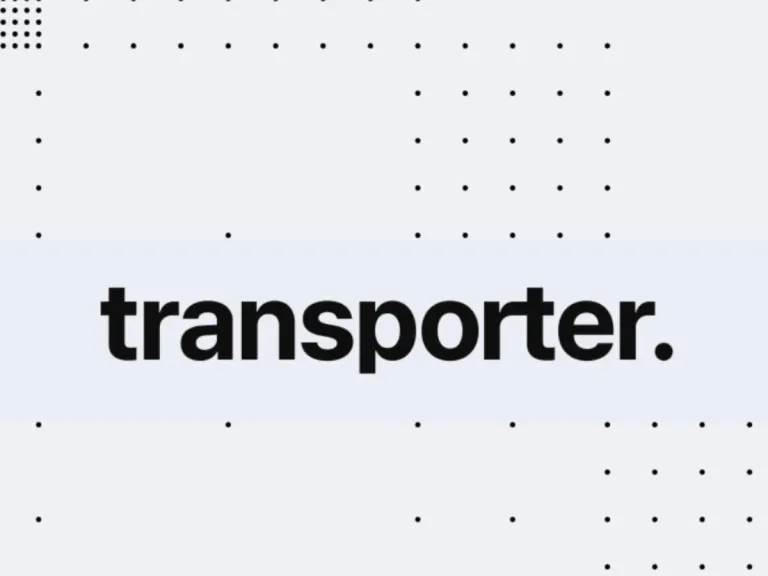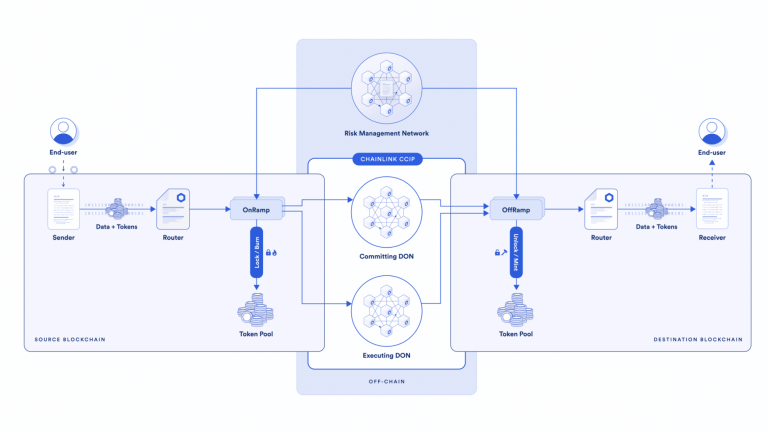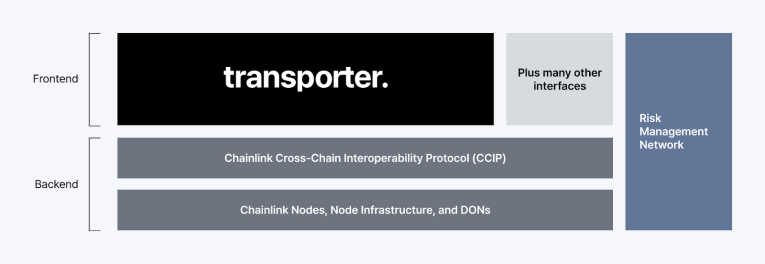 web3.0
web3.0
 The oracle Chainlink launches the cross-chain bridge Transporter based on the CCIP protocol! Expected to enhance brand value
The oracle Chainlink launches the cross-chain bridge Transporter based on the CCIP protocol! Expected to enhance brand value
The oracle Chainlink launches the cross-chain bridge Transporter based on the CCIP protocol! Expected to enhance brand value

Chainlink, a blue-chip oracle project, launched today’s cross-chain bridge Transporter based on its signature transmission protocol CCIP (Cross-Chain Interoperability Protocol). It provides services to general users for the first time and is expected to improve Chainlink Brand Value.
What is CCIP
CCIP is a cross-chain message transmission protocol launched by Chainlink. It can provide the transmission infrastructure designed by the Web3 project team based on the oracle architecture, and can integrate information from various networks more securely. .
CCIP can transmit a variety of data
The special thing about CCIP is that it is based on its own Chainlink oracle infrastructure. It can complete cross-chain without adding new trust assumptions, and it is different from ordinary cross-chain Most chain bridges can only transmit token assets, while CCIP can transmit more diverse information, including NFTs, decentralized identities, liquidity within the protocol, wallet signatures, governance voting results, etc., which can be used across chains.
For example, AAVE's governance module Aave Governance V3 is based on the CCIP protocol. It transmits the voting governance results on different blockchains to Ethereum for verification, and then transmits the verification results back to the blockchain. , to trigger a bot that updates the code.
The RPG game project KMON also recently announced that it will integrate the CCIP protocol so that game NFTs can be cross-chained to other networks without the need for the project team to build its own dedicated cross-chain bridge.
By integrating CCIP, the Ethereum domain ENS name can safely cross-chain its domain name to other networks. This mechanism is also touted by VItalik because of its security.
The advantage of CCIP is that it can more flexibly assist the transmission of diverse data in different blockchain networks without increasing complexity and trust assumptions, and maintaining protocol security.
CCIP Security
Chainlink CCIP network architecture can be mainly divided into message transmission route, risk management network (Risk Manage Network), decentralized Oracle Networks (Decentralized Oracle Networks, DON), and cooperate with the bilateral blockchain network.

CCIP protocol architecture
This architecture is the official source of CCIP’s solid security:
Decentralized prophecy Machine network: CCIP uses multiple independent decentralized oracle networks to further enhance its security. Each node has an independent key to ensure that there is no single point of failure.
Independent risk management network: CCIP has a risk management network constructed by different teams using different programming languages, which can monitor and verify the CCIP network completely independently.
Configurable transmission rate limit: CCIP’s transmission facility provides a customizable rate limit for the project team to limit the total value that can be transmitted across the chain within a specific period of time, which can reduce The impact when the worst happens.
Chainlink launches its own cross-chain bridge Transporter
Transporter introduction
Chainlink launches its own cross-chain bridge Transporter through CCIP, officially expanding its business territory to 2C cross-chain services.

Transporter User Interface
Currently, the networks supported by Transporter include Ethereum, Arbitrum, Avalanche, BNB Chain, Base, Optimism, Polygon and WEMIX.
The types of tokens supported vary by network. Almost all of them support ETH, USDC, and LINK. Some networks support LRT, such as ETHx and rsETH. It can be seen that Chainlink intends to seize market hot spots and promote this service to General participants. But what’s interesting is that there is currently no option for USDT.
Transporter security is based on CCIP
Transporter is the front-end interface for interacting with users, and the underlying layer is the oracle network infrastructure based on CCIP and Chainlink. All Transporter transmissions are protected by Chainlink CCIP, so this cross-chain transaction has all the security features of CCIP mentioned above.

Transporter is a cross-chain bridge front-end interface based on CCIP
The most important feature of cross-chain bridge is security, which has not happened since CCIP has been running. Major security incidents do have great advantages for Chainlink to launch its own cross-chain bridge Transporter.
Transporter can bring more brand value to Chainlink
In addition to driving the adoption and popularity of CCIP, Transporter can also increase the brand value of Chainlink.
Transporter is not only a new service for Chainlink, but also expands its business territory to ordinary users. It is the first attempt to go beyond the B2B and infrastructure markets. It is expected to see more oriented services in the future. Services for general users are expected to bring more brand value to Chainlink.
The above is the detailed content of The oracle Chainlink launches the cross-chain bridge Transporter based on the CCIP protocol! Expected to enhance brand value. For more information, please follow other related articles on the PHP Chinese website!

Hot AI Tools

Undresser.AI Undress
AI-powered app for creating realistic nude photos

AI Clothes Remover
Online AI tool for removing clothes from photos.

Undress AI Tool
Undress images for free

Clothoff.io
AI clothes remover

AI Hentai Generator
Generate AI Hentai for free.

Hot Article

Hot Tools

Notepad++7.3.1
Easy-to-use and free code editor

SublimeText3 Chinese version
Chinese version, very easy to use

Zend Studio 13.0.1
Powerful PHP integrated development environment

Dreamweaver CS6
Visual web development tools

SublimeText3 Mac version
God-level code editing software (SublimeText3)

Hot Topics
 1378
1378
 52
52
 How to check tablespace size of oracle
Apr 11, 2025 pm 08:15 PM
How to check tablespace size of oracle
Apr 11, 2025 pm 08:15 PM
To query the Oracle tablespace size, follow the following steps: Determine the tablespace name by running the query: SELECT tablespace_name FROM dba_tablespaces; Query the tablespace size by running the query: SELECT sum(bytes) AS total_size, sum(bytes_free) AS available_space, sum(bytes) - sum(bytes_free) AS used_space FROM dba_data_files WHERE tablespace_
 How to encrypt oracle view
Apr 11, 2025 pm 08:30 PM
How to encrypt oracle view
Apr 11, 2025 pm 08:30 PM
Oracle View Encryption allows you to encrypt data in the view, thereby enhancing the security of sensitive information. The steps include: 1) creating the master encryption key (MEk); 2) creating an encrypted view, specifying the view and MEk to be encrypted; 3) authorizing users to access the encrypted view. How encrypted views work: When a user querys for an encrypted view, Oracle uses MEk to decrypt data, ensuring that only authorized users can access readable data.
 How to import oracle database
Apr 11, 2025 pm 08:06 PM
How to import oracle database
Apr 11, 2025 pm 08:06 PM
Data import method: 1. Use the SQLLoader utility: prepare data files, create control files, and run SQLLoader; 2. Use the IMP/EXP tool: export data, import data. Tip: 1. Recommended SQL*Loader for big data sets; 2. The target table should exist and the column definition matches; 3. After importing, data integrity needs to be verified.
 How to create a table in oracle
Apr 11, 2025 pm 08:00 PM
How to create a table in oracle
Apr 11, 2025 pm 08:00 PM
Creating an Oracle table involves the following steps: Use the CREATE TABLE syntax to specify table names, column names, data types, constraints, and default values. The table name should be concise and descriptive, and should not exceed 30 characters. The column name should be descriptive, and the data type specifies the data type stored in the column. The NOT NULL constraint ensures that null values are not allowed in the column, and the DEFAULT clause specifies the default values for the column. PRIMARY KEY Constraints to identify the unique record of the table. FOREIGN KEY constraint specifies that the column in the table refers to the primary key in another table. See the creation of the sample table students, which contains primary keys, unique constraints, and default values.
 How to uninstall Oracle installation failed
Apr 11, 2025 pm 08:24 PM
How to uninstall Oracle installation failed
Apr 11, 2025 pm 08:24 PM
Uninstall method for Oracle installation failure: Close Oracle service, delete Oracle program files and registry keys, uninstall Oracle environment variables, and restart the computer. If the uninstall fails, you can uninstall manually using the Oracle Universal Uninstall Tool.
 How to view instance name of oracle
Apr 11, 2025 pm 08:18 PM
How to view instance name of oracle
Apr 11, 2025 pm 08:18 PM
There are three ways to view instance names in Oracle: use the "sqlplus" and "select instance_name from v$instance;" commands on the command line. Use the "show instance_name;" command in SQL*Plus. Check environment variables (ORACLE_SID on Linux) through the operating system's Task Manager, Oracle Enterprise Manager, or through the operating system.
 How to get time in oracle
Apr 11, 2025 pm 08:09 PM
How to get time in oracle
Apr 11, 2025 pm 08:09 PM
There are the following methods to get time in Oracle: CURRENT_TIMESTAMP: Returns the current system time, accurate to seconds. SYSTIMESTAMP: More accurate than CURRENT_TIMESTAMP, to nanoseconds. SYSDATE: Returns the current system date, excluding the time part. TO_CHAR(SYSDATE, 'YYY-MM-DD HH24:MI:SS'): Converts the current system date and time to a specific format. EXTRACT: Extracts a specific part from a time value, such as a year, month, or hour.
 How to read the oracle awr report
Apr 11, 2025 pm 09:45 PM
How to read the oracle awr report
Apr 11, 2025 pm 09:45 PM
An AWR report is a report that displays database performance and activity snapshots. The interpretation steps include: identifying the date and time of the activity snapshot. View an overview of activities and resource consumption. Analyze session activities to find session types, resource consumption, and waiting events. Find potential performance bottlenecks such as slow SQL statements, resource contention, and I/O issues. View waiting events, identify and resolve them for performance. Analyze latch and memory usage patterns to identify memory issues that are causing performance issues.


